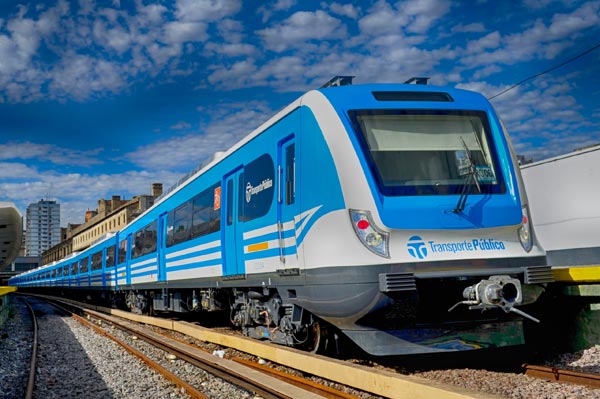
Chinese-made trains popular in Argentina


BUENOS AIRES — With colors and features of Argentina’s national flag, the new azure-and-white train fleet serving the capital Buenos Aires is the new image of the city’s public transport system, an image made in China.
“We are very proud that passengers once again feel respected to travel by train in Argentina,” said Argentine President Cristina Fernandez when the first 12 of 30 electric trains, supplied by China’s CSR for the capital’s commuter route, officially went into operation in November.
According to the $1 billion contract signed in 2013 between the Argentine government and China’s leading train maker CSR, once the project is complete, there will be 709 Chinese-made trains running in Buenos Aires, serving millions of people in the city and nearby towns.
Due to mistakes made during the privatization of the railway sector in the 1990s and a lack of investment, the capital’s rail network was old, insufficient and prone to accidents, highlighted by the fatal collision in 2012 that killed 51 people.
Argentine government announced its ambitious commuter train renewal plans in early 2013, drawing leading train makers around the world, including China’s CSR, the market leader with a cutting-edge in technology, price and operational service.
The Chinese-made passenger cars are equipped with air-conditioning, smart doors and windows, advanced traction and brake mechanisms, and high-tech surveillance and warning systems, which make the cars both safe and comfortable, Argentina’s Interior and Transport Minister Florencio Randazzo told Xinhua.
The biggest challenges for the Chinese company are the worn and twisted rails and power supply tracks in the city, which cause more friction and wearing away.
“CSR cars have very good quality and have been running safely and smoothly. To overcome the difficulties caused by the aged infrastructure, especially the railway tracks and power supply system, Chinese experts redesigned the current collectors for the network, which is rare in this industry,” said Argentine technical expert Edgardo Zanello who takes charge in channeling the Chinese technology.
Wu Houcai, CSR’s technical leader in the transaction, has been working on this project in Argentina for two years. He believes that introducing the administrative system is equally important with introducing the technology.
“We spent a lot of time with the local operators and provided them with a lot of technical training. We are doing our utmost to ensure safety and maintain our brand image. The reputation of Chinese trains would be ruined if there were an accident, even if it were caused by the aged railway tracks or incorrect operation,” said Wu.
By the end of 2014, 25 CSR cars had covered a million kilometers safely on the Sarmiento line, one of the intercity commuter routes in Buenos Aires, and increased the route’s capacity from 241,536 passengers to 461,220 passengers a day. Local operators said some 97 percent of passengers had expressed their satisfaction with the new cars.
According to an agreement the Argentine government and CSR reached last November, CSR will establish a plant at a site of the state-owned Trenes Argentinos Operadora Ferroviaria to boost the country’s railway industry.
The new plant will not only provide maintenance service, but also produce equipment and parts for CSR trains through technology transfer.
Randazzo said the plant will create new jobs, as the Chinese company uses substantial local skilled labor, and will bring the technology Argentina needs to revive its national railway industry.
CSR has been supplying trains and other rail products to Argentina since 2006. Last December, the company said it had won a $272 million contract to provide 80 locomotives and 2,000 freight rail cars for a railway renovation project in Argentina.
https://www.youtube.com/watch?v=C4oV5DZNPRM

Leave a Reply